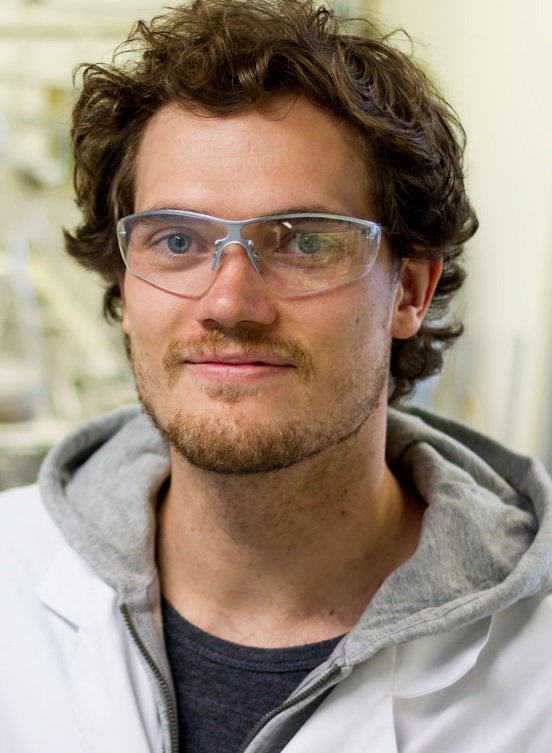Org. Synth. 2018, 95, 127-141
DOI: 10.15227/orgsyn.095.0127
Preparation of Solid Organozinc Pivalates and Their Reaction in Pd-Catalyzed Cross-Couplings
Submitted by Mario Ellwart, Yi-Hung Chen, Carl Phillip Tüllmann, Vladimir Malakhov, and Paul Knochel
*1
Checked by Kelsey E. Poremba and Sarah E. Reisman
1. Procedure (Note 1)
A.
Zinc Pivalate. A dry, tared, 500 mL round-bottomed flask equipped with a 5x2-cm Teflon-coated magnetic stirring bar and a septum is charged with
toluene (250 mL, 0.2 M) (
Note 2).
Pivalic acid (12.5 mL, 11.3 g, 110 mmol, 2.2 equiv) (
Note 3) is added to form a colorless solution.
Zinc oxide (4.07 g, 50 mmol, 1 equiv) is added in 1 g portions at 25 ºC over 15 min to form a colorless suspension (
Note 4). The flask is equipped with a Dean-Stark trap (10 mL) wrapped in aluminum foil and topped with a reflux condenser (20 cm) and the suspension is stirred under
nitrogen at reflux in an oil bath for 16 h (Figure 1) (
Note 5).
Figure 1: Step A - Dean-Stark trap and evaporation of remaining pivalic acid and water with a liquid nitrogen cold trap
A viscous colorless suspension is formed overnight. After cooling to 25 ºC, the mixture is concentrated by rotary evaporation (50 °C/50 mmHg). The remaining pivalic acid and water are removed in vacuo from the reaction mixture using a vacuum line (0.1 mmHg) and a liquid nitrogen cold trap (1000 mL) (see Figure 1). The white solid is warmed to 100 °C in an oil bath and dried for at least 6 h (Note 6). Zinc pivalate (13.1-13.2 g, 48.9-49.7 mmol, 98-99%), is obtained as a puffy amorphous white solid (Note 7).
B. Pyridin-3-ylzinc Pivalate. A dry and argon flushed 1 L Schlenk-flask equipped with a 5×2-cm Teflon-coated magnetic stirring bar and a septum is filled with argon and then weighed. 3-Bromopyridine (6.32 g, 40.0 mmol, 1 equiv) (Note 8) and dry THF (50 mL, 0.8 M) are added to the flask via syringe (Note 9). The solution is cooled in an ice-water bath under an atmosphere of argon and stirred for at least 5 min at 0 °C before iPrMgCl·LiCl (35.2 mL, 1.25 M, 44.0 mmol, 1.1 equiv) (Note 10) is added via a syringe pump over the period of 30 min (Note 11). The ice bath is removed and the solution is stirred for 3 h at 25 °C during which time it gradually turns from yellow to dark red (Note 12). Upon completion of the reaction, solid Zn(OPiv)2 (12.3 g, 46.0 mmol, 1.15 equiv) is added in one portion under argon counterflow via a powder funnel. A slight exotherm is noticed (Note 13). The mixture is stirred at 25 °C for 30 min leading to a clear dark red solution. The solvent is removed using a vacuum line (0.1 mmHg) and a liquid nitrogen cold trap. The solid residue is dried for at least 2 h longer leading to a voluminous yellow foam (Figure 2) (Note 14). The foam is crushed with a spatula under argon counterflow to form a fine yellow powder. This powder is dried under high vacuum (0.1 mmHg) for further 2 h. The resulting pyridine-3-ylzinc pivalate (28.6-28.8 g, 1.1-1.20 mmol g-1, 31.5-34.5 mmol, 79-86%) is used immediately.
After the drying process is complete, the argon-flushed flask is weighed to determine the weight of the resulting powder. To determine the actual content in zinc species and the reaction yield, a small aliquot of the powder (accurately weighed amount, ca. 1 g, see Figure 3: a) is titrated using a 1 M solution of
iodine in
THF (
Note 15) with a color change from red (b) to bright yellow (c) until the persisting brown color of the
iodine (d) indicates the completion of the titration (
Note 16).
Figure 2: Step B - The color of the reaction mixture turns from yellow to dark red. Photographs of the solid foam and powder.
Figure 3: Step B - Titration of the organozinc reagent. a) solid zinc reagent. b) before the iodometric titration. c) titration before color change. d) titration after color change
C. Ethyl 4-(Pyridin-3-yl)benzoate. To the dry and argon-flushed 1 L flask, containing the solid pyridine-3-ylzinc pivalate (27.2 g, 32.6 mmol, 1.20 mmol g-1, 1.15 equiv), a 5×2-cm Teflon-coated magnetic stirring bar and a septum, is added dry THF (65 mL, 0.44 M). Ethyl 4-bromobenzoate (4.6 mL, 6.45 g, 28.2 mmol, 1 equiv) (Note 17) is added via syringe. The septum is temporarily removed and PEPPSI-IPr (193 mg, 0.28 mmol, 1 mol%)2 added, after which the septum is reconnected and the flask flushed with argon. The red solution is stirred for 2 h at room temperature (25 °C) under an atmosphere of argon (Note 18). Then sat. aq. NH4Cl (50 mL) is added and the aqueous layer is extracted with EtOAc (3 × 70 mL). The combined organic phases are dried (12 g MgSO4). After filtration and evaporation of the solvent in vacuo, purification by column chromatography (hexane:EtOAc:NEt3 = 50:10:1 → 50:25:1) (Note 19) afforded ethyl 4-(pyridin-3-yl)benzoate (6.02 g, 26.5 mmol, 94%) as a yellow solid (Notes 20, 21, and 22).
2. Notes
1. Prior to performing each reaction, a thorough hazard analysis and risk assessment should be carried out with regard to each chemical substance and experimental operation on the scale planned and in the context of the laboratory where the procedures will be carried out. Guidelines for carrying out risk assessments and for analyzing the hazards associated with chemicals can be found in references such as Chapter 4 of "Prudent Practices in the Laboratory" (The National Academies Press, Washington, D.C., 2011; the full text can be accessed free of charge at
https://www.nap.edu/catalog/12654/prudent-practices-in-the-laboratory-handling-and-management-of-chemical. See also "Identifying and Evaluating Hazards in Research Laboratories" (American Chemical Society, 2015) which is available via the associated website "Hazard Assessment in Research Laboratories" at
https://www.acs.org/content/acs/en/about/governance/committees/chemicalsafety/hazard-assessment.html. In the case of this procedure, the risk assessment should include (but not necessarily be limited to) an evaluation of the potential hazards associated with
pivalic acid, aluminum foil,
zinc oxide,
toluene, liquid
nitrogen,
3-bromopyridine,
tetrahydrofuran,
iPrMgCl·LiCl,
iodine,
ethyl 4-bromobenzoate,
PEPPSI-IPr,
ammonium chloride,
ethyl acetate,
magnesium sulfate,
hexane, and
triethylamine.
2.
Toluene was used after purification through activated alumina using a Glass Contour solvent purification system.
3.
Pivalic acid (99%) was obtained from Acros Organics and warmed to 60 °C ca. 1 h prior to the addition. The molten
pivalic acid (mp = 35 °C) can be easily added by quickly handling via syringe.
4.
Zinc oxide was obtained from Sigma Aldrich or Panreac AppliChem and was used without any further purification.
5. The trap was filled up with
toluene. After 16 h, water (0.9 mL, 50 mmol) was obtained in the Dean-stark trap and residues of
pivalic acid could be observed on the bottom of the condenser and the Dean-Stark trap.
6. The flask was connected to high vacuum (0.1 mmHg) with a liquid
nitrogen cold trap. Vigorous stirring (800 rpm) was maintained to keep the solid from heterogenization.
7.
Zinc pivalate should be stored under argon, but can be weighed on air. The product was characterized as follows: mp 305-315 °C (sublimation);
1H NMR
pdf(500 MHz, DMSO-
d6) δ : 1.08 (s, 9H);
13C NMR
pdf(101 MHz, DMSO-
d6) δ : 28.3, 37.8, 184.0; IR (diamond ATR, neat): 2962, 2929, 1606, 1534, 1481, 1457, 1426, 1378, 1361, 1228, 1031, 937, 899, 791, 609 cm
-1. Purity >97% as assessed by quantitative NMR
pdf, in which ethylene carbonate is used as the internal standard. Conditions:
Zn(OPiv)2 (19.8 mg); standard (17.3 mg) Solvent: DMSO.
8. 3-Bromopyridine (99%) was purchased from Apollo Scientific and used as received.
9.
THF was used after purification through activated alumina using a Glass contour solvent purification system.
10. A KDS single-syringe pump (series 100) was used with a 50 mL NORM-JECT syringe and a 1.10 x 120 mm TSK-SUPRA needle. The
iPrMgCl·LiCl solution was added with a rate of 1.16 mL/min.
11. A solution of
iPrMgCl·LiCl in
THF was obtained from Sigma Aldrich or Albemarle (Frankfurt) and titrated against
iodine prior to use. For the titration accurately weighted aliquots (e.g. 221 mg) of
iodine were placed in a dry and argon flushed 20 mL Schlenk-flask with a septum and dissolved in ca. 2 mL dry
THF. To the resulting solution was added the
iPrMgCl·LiCl solution using a 1 mL NORM-JECT syringe from Henke Sass Wolf until the complete disappearance of the dark brown color of
iodine (0.69 mL equals a concentration of 1.26 M).
12. The progress of the halogen-magnesium exchange was monitored by GC-analysis of reaction aliquots quenched with
iodine or NMR analysis after
NH4Cl quench of reaction aliquot. GC analysis was performed using an Agilent Technologies 6850 Series equipped with an HP-5 column (J&W Scientific) (15m x 0.25mm x 0.25μm). Oven program for GC analysis: Starting temperature 70 °C for 0.5 min; heating to 250 °C at a rate of 50 °C/min; 5 min at 250 °C.
13. Reaction mixture warmed to 40 ºC internal temperature.
14. The flask was warmed in a 20 °C water bath in order to accelerate the solvent evaporation.
15. A 1 M solution of
iodine in
THF was prepared in a dry and argon flushed 20 mL Schlenk-flask by dissolving 2.54 g I
2 in 9.30 mL dry
THF.
16. For the titration accurately weighted aliquots (e.g. 913 mg) of the powder were placed in a dry and argon flushed 20 mL Schlenk-flask with a septum and dissolved in dry
THF (ca. 3 mL). To the resulting solution was added the 1 M
iodine solution using a 1 mL NORM-JECT syringe from Henke Sass Wolf until the persistence of the dark brown color of
iodine (e.g. 1.19 mL equals a concentration of 1.30 mmol/g).
17. The following reagents in this section were purchased from commercial sources and used without further purification:
ethyl 4-bromobenzoate (99+%, Apollo Scientific),
PEPPSI-IPr (98%, Sigma-Aldrich).
18. The cross-coupling was monitored by NMR analysis of reaction aliquots.
19. Five grams of ISOLUTE
® HM-N adsorbed with the crude product was dry-loaded onto a column (diameter: 6.0 cm, height: 25.0 cm) packed with silica gel (250 g) slurry in 50:10:1
hexane:
EtOAc:
NEt3 (R
f(product): 0.12; visualized with UV light) and 100 mL fractions were collected. The desired product was obtained in fractions 20-80 (50:25:1
hexane:
EtOAc:
NEt3), which are concentrated by rotary evaporation (40 °C, 250 mmHg). The purified product is stored under an inert atmosphere in the dark for long-term storage.
20. The product has been characterized as follows: mp: 44-46 °C;
1H NMR
pdf(400 MHz, CDCl
3) δ : 1.41 (t,
J = 7.1 Hz, 3H), 4.40 (q,
J = 7.2 Hz, 2H), 7.38 (ddd,
J = 7.9, 4.8, 0.9 Hz, 1H), 7.61-7.68 (m, 2H), 7.89 (ddd,
J = 7.9, 2.4, 1.6 Hz, 1H), 8.10-8.17 (m, 2H), 8.63 (dd,
J = 4.8, 1.6 Hz, 1H), 8.87 (dd,
J = 2.4, 0.9 Hz, 1H);
13C NMR
pdf(101 MHz, CDCl
3) δ : 14.5, 61.2, 123.7, 127.1, 130.2, 130.4, 134.6, 135.7, 142.2, 148.5, 149.4, 166.3; IR (diamond ATR, neat): 2985, 2909, 1700, 1608, 1471, 1425, 1366, 1275, 1192, 1181, 1124, 1102, 1021, 1000, 856, 815, 765, 711, 700 cm
-1. HRMS (ESI-TOF)
pdf:
m/z calc. for [C
14H
13NO
2]: 227.0946; found: 227.0950 (M
+).
21. A second reaction on similar scale provided 5.17 g (91%) of the product.
22. Purity of the product was determined by the Checkers as >97% by quantitative NMR, in which ethylene carbonate is used as the internal standard. Conditions: product (27.2 mg); standard (17.0 mg) Solvent: CDCl
3. Purity of the product was determined by the authors to be >98% by GC analysis. The Submitters performed GC analysis using an Agilent Technologies 6850 Series equipped with an HP-5 column (J&W Scientific) (15m x 0.25mm x 0.25μm). Oven program for GC analysis: Starting temperature 70 °C for 0.5 min; heating to 250 °C at a rate of 50 °C/min; 5 min at 250 °C.
Working with Hazardous Chemicals
The procedures in
Organic Syntheses are intended for use only by persons with proper training in experimental organic chemistry. All hazardous materials should be handled using the standard procedures for work with chemicals described in references such as "Prudent Practices in the Laboratory" (The National Academies Press, Washington, D.C., 2011; the full text can be accessed free of charge at
http://www.nap.edu/catalog.php?record_id=12654). All chemical waste should be disposed of in accordance with local regulations. For general guidelines for the management of chemical waste, see Chapter 8 of Prudent Practices.
In some articles in Organic Syntheses, chemical-specific hazards are highlighted in red "Caution Notes" within a procedure. It is important to recognize that the absence of a caution note does not imply that no significant hazards are associated with the chemicals involved in that procedure. Prior to performing a reaction, a thorough risk assessment should be carried out that includes a review of the potential hazards associated with each chemical and experimental operation on the scale that is planned for the procedure. Guidelines for carrying out a risk assessment and for analyzing the hazards associated with chemicals can be found in Chapter 4 of Prudent Practices.
The procedures described in Organic Syntheses are provided as published and are conducted at one's own risk. Organic Syntheses, Inc., its Editors, and its Board of Directors do not warrant or guarantee the safety of individuals using these procedures and hereby disclaim any liability for any injuries or damages claimed to have resulted from or related in any way to the procedures herein.
3. Discussion
The performance of cross-couplings between Csp
2-centers is a major synthetic concern due to the importance of the resulting products as potential pharmaceuticals, agrochemicals, or new organic materials. Organozincs are excellent nucleophilic candidates for such cross-couplings since the labile carbon-zinc bond undergoes fast transmetalations with numerous transition metals under mild conditions due to the presence of empty low-lying p-orbitals at the zinc center. Also, zinc (II) salts are ecologically friendly salts of low inherent toxicity. The only drawbacks are the moisture and air sensitivity of organozinc derivatives which precludes their handling in air. In 2011, our research group developed a range of aryl- and heteroaryl zinc derivatives with significantly enhanced air and moisture stability.
3 We have reported that the treatment of an aryl bromide such as
1a with magnesium powder in the presence of Zn(OPiv)
2·2LiCl provides the corresponding zinc organometallic species (
2a) conveniently abbreviated as
3a and called organozinc pivalates knowing that the improved water and air stability may be due to the presence of magnesium pivalate
4 (Scheme 1).
Scheme 1: Preparation of a solid arylzinc pivalate via the direct magnesium insertion in the presence of Zn(OPiv)2·2LiCl
Alternatively, these organozinc pivalates may be prepared by directed metalation using either TMPMgCl·LiCl
5,6 followed by the addition of
Zn(OPiv)2 or TMPZnOPiv
7 prepared in situ. Thus, the treatment of ethyl 3-fluorobenzoate (
1b) with TMPMgCl·LiCl at 0 °C in
THF followed by the addition of
Zn(OPiv)2 and subsequent solvent evaporation produces the functionalized solid arylzinc pivalate
3b in 92% yield.
5 Heterocyclic zinc reagents are prepared similarly and the use of TMPZnOPiv may be advantageous. Thus, the reaction of 4,6-dichloropyrimidine (
1c) with TMPZnOPiv·LiCl in
THF at ambient temperatures furnishes after solvent evaporation the corresponding heteroarylzinc pivalate (
3c) in 78%.
7 This particular heteroarylzinc pivalate is air-stable with almost no activity loss after 4 h in air (Scheme 2).
Scheme 2: Preparation of solid aryl and heteroarylzinc pivalates by directed metalation using TMPMgCl·LiCl and TMPZnOPiv·LiCl
This method has a broad scope and a range of polyfunctional zinc reagents like
3d-s have been prepared in satisfactory yields (Scheme 3).
Scheme 3: Various organozinc pivalates prepared by directed metalation
All these aryl- and heteroarylzinc reagents have improved air and moisture stability.
8 They readily undergo palladium- or cobalt catalyzed cross-coupling reactions (Scheme 4).
5,9
Scheme 4: Pd- and Co-catalyzed cross-couplings of organozinc pivalates
The cross-coupling conditions are usually mild and comparable to those of regular organozinc halides. Also these organozinc pivalates undergo readily acylation reactions and copper-catalyzed allylations.
10 Finally, benzylic zinc pivalates can be prepared according to the same methods as well as allylic zinc pivalates which are also stable in a solid state (in the latter case under argon).
11
In conclusion, aryl and heteroarylzinc pivalates are convenient zinc reagents suitable for a wide range of carbon-carbon bond forming reactions. They are easy to prepare using either a direct magnesium insertion in the presence of zinc pivalate or can be prepared by a directed metalation using either TMPMgCl·LiCl and Zn(OPiv)2 or TMPZnOPiv·LiCl. Their low toxicity and compatibility with a wide range of functional groups makes them valuable organometallic reagents for both academic and industrial applications.
Appendix
Chemical Abstracts Nomenclature (Registry Number)
Zinc Pivalate: Propanoic acid, 2,2-dimethyl-, zinc salt (2:1); (15827-10-8)
Pivalic acid: Propanoic acid, 2,2-dimethyl-; (75-98-9)
Zinc oxide: Oxozinc; (1314-13-2)
Pyridin-3-ylzinc Pivalate: Zinc, (2,2-dimethylpropanoato-κO)-3-pyridinyl-; (1344727-29-2)
3-Bromopyridine: Pyridine, 3-bromo-; (626-55-1)
iPrMgCl·LiCl: Magnesate(1-), dichloro(1-methylethyl)-, lithium (1:1); (745038-86-2)
Ethyl 4-(Pyridin-3-yl)benzoate: Benzoic acid, 4-(3-pyridinyl)-, ethyl ester; (4385-71-1)
Ethyl 4-bromobenzoate: Benzoic acid, 4-bromo-, ethyl ester; (5798-75-4)
PEPPSI-IPr: Palladium, [1,3-bis[2,6-bis(1-methylethyl)phenyl]-1,3-dihydro-2H-imidazol-2-ylidene]dichloro(3-chloropyridine-κN)-, (SP-4-1)-; (905459-27-0)

|
Mario Ellwart was born in Munich (Germany) in 1987. He studied chemistry at the Ludwig-Maximilians-Universität München and joined the research group of Prof. Paul Knochel in 2012. His research focuses on the synthesis of novel organozinc reagents and their applications in organic synthesis. |

|
Yi-Hung Chen was born in Taipei (Taiwan) in 1977. He studied chemistry at the National Tsing Hua university in Taiwan and started his Ph.D. in the research group of Prof. Frank E. McDonald at Emory university in 2002. His research focused on the polyketide based natural product synthesis. In 2007, he completed his Ph.D. and joined the group of Prof. Paul Knochel as a Humboldt fellow and continued to stay in the same group as research assistant. His research focused on the preparation organometallic reagents and their applications in organic synthesis. |

|
Carl Phillip Tüllmann was born in Düsseldorf (Germany) in 1992. He studied chemistry at the Albert-Ludwigs-University in Freiburg and the Ludwig-Maximilians-University in Munich. He prepared his master thesis at Prof. Ian Seiple’s working group at UCSF and joined the research group of Prof. Paul Knochel for his PhD in 2017. His research focuses on the synthesis of novel organozinc reagents and their applications in organic synthesis. |

|
Vladimir Malakhov was born in Moscow (Russia) in 1965. He completed his undergraduate studies in pharmacy at the I. M. Sechenov Moscow Medical Academy (1985-1990). In 1997, he joined Prof. P. Knochel's group at the Philipps-Universität Marburg (Germany) and moved in 1999 with him to the Ludwig-Maximilians-Universität Munich (Germany). He completed his Ph.D. under supervision of Prof. P. Knochel, which focused on polyfunctional organozinc reagents. |

|
Paul Knochel was born 1955 in Strasbourg (France). He carried out his undergraduate studies at the University of Strasbourg (France) and his Ph.D. at the ETH-Zürich with Prof. Dieter Seebach. He spent four years at the CNRS at the University Pierre and Marie Curie in Paris with Prof. Jean F. Normant and one year of postdoctoral studies at Princeton University in the laboratory of Prof. Martin F. Semmelhack. In 1987, he accepted a position as Assistant Professor at the University of Michigan at Ann Arbor, USA. In 1991, he became Full Professor, then in 1992, he moved to the Philipps University at Marburg (Germany) as C4-Professor in organic chemistry. In 1999, he moved again to the Chemistry Department of the Ludwig-Maximilians-University in Munich (Germany). His research interests include the development of novel organometallic reagents and methods for their use in organic synthesis, asymmetric catalysis and natural product synthesis. |

|
Kelsey Poremba received her B.A. from the College of the Holy Cross in Worcester, Massachusetts in 2014, where she conducted research in the lab of Professor Bianca R. Sculimbrene. She is currently pursuing her Ph.D. in the lab of Professor Sarah E. Reisman. Her graduate research is focused on the development of nickel-catalyzed asymmetric reductive cross-coupling reactions. |
Copyright © 1921-, Organic Syntheses, Inc. All Rights Reserved